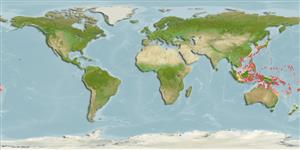Common names from other countries
Environment: milieu / climate zone / depth range / distribution range
Écologie
; profondeur 6 - 20 m (Ref. 864). Tropical
Pacific Ocean.
Length at first maturity / Taille / Poids / Âge
Maturity: Lm ? range ? - ? cm
Depth based on occurrence from Palau; to be replaced with a better reference (Ref. 864). Combination depth range: min from literature, max from estimate. Collected from the intertidal (Ref. 116475). Found offshore on sandy bottoms (Ref. 799).
Life cycle and mating behavior
Maturité | Reproduction | Frai | Œufs | Fécondité | Larves
Members of the order Neotaenioglossa are mostly gonochoric and broadcast spawners. Life cycle: Embryos develop into planktonic trocophore larvae and later into juvenile veligers before becoming fully grown adults.
Smith, B.D. 2003. (Ref. 3116)
Statut dans la liste rouge de l'IUCN (Ref. 130435)
statut CITES (Ref. 108899)
Not Evaluated
Not Evaluated
Menace pour l'homme
Harmless
Utilisations par l'homme
| FishSource |
Outils
Plus d'informations
Taille/ÂgeCroissanceLongueur-poidsLongueur-longueurMorphologieLarvesAbondance
Sources Internet
Estimates based on models
Preferred temperature
(Ref.
115969): 21.2 - 29.3, mean 28.7 (based on 1392 cells).
